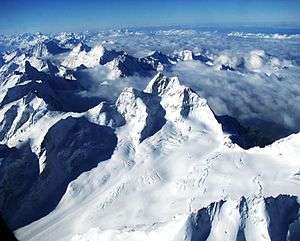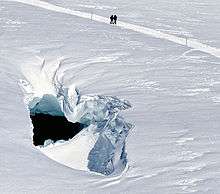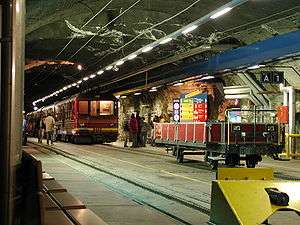Jungfraujoch
Jungfraujoch is a saddle[note 1] in the Bernese Alps, connecting the two four-thousander peaks Jungfrau[note 2][2][3] and Mönch, at an elevation of 3,466 metres (11,371 ft) above sea level. It is a glacier saddle, on the upper snows of the Aletsch Glacier, and part of the Jungfrau-Aletsch area, situated on the boundary between the cantons of Bern and Valais, halfway between Interlaken and Fiesch.

| Jungfraujoch | |
|---|---|
 The Bernese Alps with Jungfrau in the middle, and Jungfraujoch, its saddle, to the right, and the Jungfraufirn; as seen from east | |
| Highest point | |
| Elevation | 3,466 m (11,371 ft) [1] |
| Coordinates | 46°32′50″N 7°58′50″E |
| Naming | |
| English translation | Virgin Yoke |
| Language of name | German |
| Geography | |
 Jungfraujoch Location in Switzerland | |
| Country | Switzerland |
| Cantons | Bern and Valais |
| Parent range | Bernese Alps |
| Topo map | Swiss Federal Office for Topography - swisstopo |
| Climbing | |
| First ascent | traversed by Leslie Stephen and party (1862) |
Since 1912, the Jungfraujoch has been accessible to tourists by the Jungfrau line, a railway from Interlaken and Kleine Scheidegg, running partly underground through a tunnel through the Eiger and Mönch. The Jungfraujoch railway station, at an elevation of 3,454 metres (11,332 ft) is the highest in Europe. It lies east of the saddle, below the Sphinx station, and is connected to the Top of Europe building, which includes several panoramic restaurants and a post office. Several tunnels lead outside, where secured hiking trails on the crevassed glacier can be followed, in particular to the Mönchsjoch Hut.
The Sphinx Observatory, one of the highest astronomical observatories in the world, provides an additional viewing platform at a height of 3,572 metres (11,719 ft). It can be reached by an elevator from the Jungfraujoch. The observatory houses one of the Global Atmosphere Watch's atmospheric research stations. The Jungfraujoch radio relay station, which is not accessible to the public, is installed west of the Jungfraujoch, on the Jungfrau ridge. It is Europe's highest radio relay station.

First ascent

There is a tradition in the Bernese Oberland, supported by some documentary evidence, that a pass existed between Grindelwald and Fiesch in Valais in the late medieval period, later lost to the advancing glaciers.
With the early development of tourism in Switzerland and the exploration of the High Alps in the 19th century, there were once again attempts to traverse the great ridge that encloses the head of the Aletsch Glacier, and connecting the Eggishorn with Grindelwald and Wengernalp. Four such routes were found, with the Jungfraujoch and the Eigerjoch being among the most difficult passes in the Alps.[4]
The first passage of Jungfraujoch succeeded in July 1862, by a party of six English climbers and six Swiss guides: Leslie Stephen, F. J. Hardy, H. B. George, Living, Moore, and Morgan, with Christian Almer, Christian and Peter Michel, Ulrich Kauffmann, P. Baumann, and C. Bohren as guides. The time of ascent from Wengernalp was nine hours.
The party turned back on the first day at a bergschrund, returning on the following day with a ladder 25 ft (7.6 m) in length, carried by Peter Rubi, a porter from Grindelwald. The way lay at first by the rocky buttress of the Mönch, separating the Eiger and Guggi glaciers. From the buttress the route descended a short distance in order to reach the Guggi Glacier, which could be ascended to a plateau. This halting place was reached in about three hours.
Above the bergschrund was a second and smaller plateau which was situated immediately under the long slopes of broken neve that lay below the saddle. The final and very arduous stage in the ascent was a single patch of dark rocks jutted out from the snow in the ridge connecting the Jungfrau with the Mönch. After more than an hour of climbing, a great wall of ice, whose projecting cornice of snow was fringed by long icicles, had to be avoided bearing left in the direction of the Mönch, along the base of the wall by a slippery pathway of ice formed from the dripping from the icicles above. At a point where the pathway thinned out nearly to a point, and was cut across by a transverse crevasse, the wall became low enough to be scaled by the ladder. This was the last serious obstacle: a moderate slope of névé, unbroken by crevasses, then led up to the summit of the saddle.
After reaching the first patch of rocks, a short way below the saddle on the south side, the party divided: George and Moore, with C. Almer and U. Kaufmann went down to the Eggishorn, while the remainder of the party returned to Grindelwald by the Mönchsjoch.[4]
Jungfraujoch railway
History
Adolf Guyer-Zeller first thought of the idea of a tunnel in 1893, and at that point, he had planned to have seven stations inside the tunnel before reaching the peak of the Sphinx. The building of the tunnel started on July 27, 1896 and took 16 years to complete.[5] The construction phase was troubled by many problems including monetary shortages, inclement weather and mounting deaths due to construction accidents. The worst accident occurred in 1908, when 30 tons of dynamite accidentally exploded.
When construction finally finished, the railway reached only to the height of the Jungfraujoch saddle, rather than the summit of the Sphinx, and had only two intermediate stations. However, even in its current state, the Jungfraubahn is a significant achievement in engineering and construction, still holding the title for highest railway in Europe.
Railway


The train into the mountain leaves from Kleine Scheidegg, which can be reached by trains from Grindelwald and Lauterbrunnen. The train enters the tunnel running eastward through the Eiger shortly after leaving Kleine Scheidegg.
It runs close behind the Eiger's north face, stopping at Eigerwand, where there is a window about 8 m long and a metre high, halfway up the face. The windows have been placed in holes used to remove excavated rock from the tunnel during construction, and are also occasionally used as access points, by climbers, and also rescue parties. This window was used for one of the final scenes of a Clint Eastwood spy movie, The Eiger Sanction. There one can get off the train to admire the view before the train continues five minutes later. The tunnel then turns west, heading towards the Jungfrau. There is a second stop at a window looking out on the Eismeer ("Sea of Ice") before the train continues to the Jungfraujoch. The tunnel was constructed between 1898 and 1912; it is about 7 kilometers (4.3 mi) long, with gradients of up to 25%. The journey from Kleine Scheidegg to Jungfraujoch takes approximately 50 minutes including the stops at Eigerwand and Eismeer; the downhill return journey taking only 35 minutes.
The Jungfraujoch complex plays an important role in John Christopher's The Tripods novels.
Climate
Jungfraujoch has an alpine tundra climate (ET) bordering very closely on a polar ice cap climate (EF) with long, cold winters lasting most of the year and a brief period during summer where the average daily highs rise above freezing.
| Climate data for Jungfraujoch, elevation: 3,580 m (11,745 ft), 1981–2010 normals, extremes 1973–present | |||||||||||||
|---|---|---|---|---|---|---|---|---|---|---|---|---|---|
| Month | Jan | Feb | Mar | Apr | May | Jun | Jul | Aug | Sep | Oct | Nov | Dec | Year |
| Record high °C (°F) | 4.2 (39.6) |
2.9 (37.2) |
8.2 (46.8) |
4.9 (40.8) |
10.0 (50.0) |
13.1 (55.6) |
14.3 (57.7) |
12.8 (55.0) |
11.6 (52.9) |
10.0 (50.0) |
4.5 (40.1) |
7.1 (44.8) |
14.3 (57.7) |
| Average high °C (°F) | −9.7 (14.5) |
−10.5 (13.1) |
−9.4 (15.1) |
−7.0 (19.4) |
−2.5 (27.5) |
0.8 (33.4) |
3.1 (37.6) |
3.0 (37.4) |
0.3 (32.5) |
−2.3 (27.9) |
−6.9 (19.6) |
−8.9 (16.0) |
−4.2 (24.4) |
| Daily mean °C (°F) | −12.8 (9.0) |
−13.6 (7.5) |
−12.4 (9.7) |
−10.2 (13.6) |
−5.5 (22.1) |
−2.4 (27.7) |
0.1 (32.2) |
0.1 (32.2) |
−2.5 (27.5) |
−5.0 (23.0) |
−9.7 (14.5) |
−12.0 (10.4) |
−7.2 (19.0) |
| Average low °C (°F) | −15.7 (3.7) |
−16.4 (2.5) |
−15.1 (4.8) |
−12.7 (9.1) |
−7.9 (17.8) |
−4.9 (23.2) |
−2.3 (27.9) |
−2.2 (28.0) |
−4.8 (23.4) |
−7.5 (18.5) |
−12.3 (9.9) |
−14.7 (5.5) |
−9.7 (14.5) |
| Record low °C (°F) | −34.2 (−29.6) |
−35.4 (−31.7) |
−28.9 (−20.0) |
−25.2 (−13.4) |
−22.0 (−7.6) |
−16.4 (2.5) |
−14.0 (6.8) |
−13.0 (8.6) |
−16.0 (3.2) |
−21.7 (−7.1) |
−30.0 (−22.0) |
−30.7 (−23.3) |
−35.4 (−31.7) |
| Average relative humidity (%) | 63 | 66 | 70 | 74 | 79 | 77 | 75 | 74 | 71 | 67 | 67 | 66 | 71 |
| Mean monthly sunshine hours | 124 | 125 | 151 | 156 | 161 | 175 | 197 | 196 | 176 | 147 | 116 | 109 | 1,832 |
| Percent possible sunshine | 52 | 52 | 45 | 40 | 37 | 42 | 46 | 47 | 50 | 53 | 48 | 48 | 46 |
| Source 1: MeteoSwiss[6] | |||||||||||||
| Source 2: Infoclimat.fr (extremes)[7] | |||||||||||||
Notes and references
Notes
- Swiss and Austro-Bavarian German Joch (lit. "yoke") is a term for "ridge between two higher peaks" recorded in the 14th century (Grimm, Deutsches Wörterbuch "bereits im 14. jahrh. als ortsname: des gotzhus zwing und ban vahet an Rotenhalden und denne die roten bachtalen uf unz an den grat, und den grat obnan hin ob Grüblen hin iemerme, unz an Joch. und ab Joch unz an Stoerben. weisth. 1, 4 (Zürich)").
- The name Jungfrau ("maiden, virgin") of the peak is most likely derived from the name Jungfrauenberg given to Wengernalp, so named for the nuns of Interlaken Monastery, its historical owner, but the "virgin" peak was heavily romanticized as "goddess" or "priestess" in late 18th to 19th century Romanticism; after the first ascent in 1811 by Swiss alpinist Johann Rudolf Meyer, the peak was jokingly referred to as "Mme Meyer" (Mrs. Meyer).
References
- Retrieved from the Swisstopo topographic maps
- Therese Hänni (3 August 2011). "1811 verlor die Jungfrau ihre Unschuld". 20minuten online (in German). Zurich, Switzerland. Retrieved 2016-02-11.
- Daniel Anker: Jungfrau in German, French and Italian in the online Historical Dictionary of Switzerland, 2008.
- John Ball, The Alpine guide, Central Alps, p. 106, 1866, London
- "Jungfraubahn - History of the Jungfrau Railway".
- "Climate normals Jungfraujoch (Reference period 1981–2010)" (PDF). Jungfraujoch: Swiss Federal Office of Metreology and Climatology, MeteoSwiss. 26 April 2016. Retrieved 22 August 2019.
- "Normales et records climatologiques 1981-2010 à Jungfraujoch - Infoclimat". www.infoclimat.fr. Retrieved 2019-08-03.
External links
| Wikimedia Commons has media related to Jungfraujoch. |